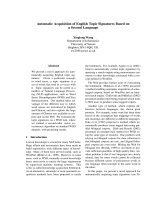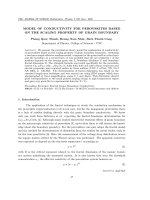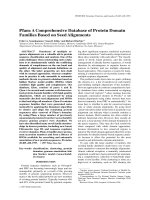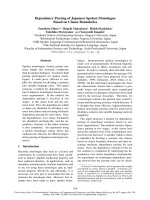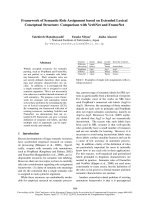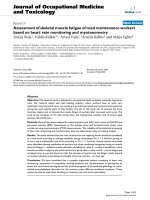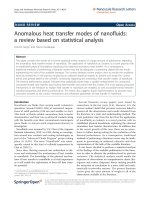Experimental realization of generalized qubit measurements based on quantum walks
Bạn đang xem bản rút gọn của tài liệu. Xem và tải ngay bản đầy đủ của tài liệu tại đây (929.87 KB, 7 trang )
PHYSICAL REVIEW A 91, 042101 (2015)
Experimental realization of generalized qubit measurements based on quantum walks
Yuan-yuan Zhao,
1,2
Neng-kun Yu,
3,4
Paweł Kurzy
´
nski,
5,6
Guo-yong Xiang,
1,2,*
Chuan-Feng Li,
1,2
and Guang-Can Guo
1,2
1
Key Laboratory of Quantum Information, University of Science and Technology of China, CAS, Hefei 230026, People’s Republic of China
2
Synergetic Innovation Center of Quantum Information and Quantum Physics, University of Science and Technology of China, Hefei,
Anhui 230026, People’s Republic of China
3
The Institute for Quantum Computing, University of Waterloo, Waterloo, Ontario, Canada
4
Department of Mathematics&Statistics, University of Guelph, Guelph, Ontario, Canada
5
Centre for Quantum Technologies, National University of Singapore, 3 Science Drive 2, 117543 Singapore, Singapore
6
Faculty of Physics, Adam Mickiewicz University, Umultowska 85, 61-614 Pozna
´
n, Poland
(Received 16 January 2015; published 6 April 2015)
We report an experimental implementation of a single-qubit generalized measurement scenario, the
positive-operator valued measure (POVM), based on a quantum walk model. The qubit is encoded in a
single-photon polarization. The photon performs a quantum walk on an array of optical elements, where the
polarization-dependent translation is performed via birefringent beam displacers and a change of the polarization
is implemented with the help of wave plates. We implement: (i) trine POVM, i.e., the POVM elements uniformly
distributed on an equatorial plane of the Bloch sphere; (ii) symmetric-informationally-complete (SIC) POVM;
and (iii) unambiguous discrimination of two nonorthogonal qubit states.
DOI: 10.1103/PhysRevA.91.042101 PACS number(s): 03.65.Ta, 03.67.Ac, 03.67.Lx, 42.25.Hz
I. INTRODUCTION
The basic unit of quantum information is a two-level
quantum system commonly known as a qubit. Qubits can
be implemented on physical objects such as polarization
of photons or intrinsic angular momentum (spin 1/2) of
quantum particles. Any quantum computation relies on precise
preparations, transformations, and measurements of such
systems. Before an actual quantum computer is build, one
has to master the ability to manipulate with single qubits and
learn how to read out information encoded in them.
The information readout from a quantum system is done via
a measurement. In the most common scenario one performs
the von Neumann measurement, which projects a state of the
qubit onto one of two perfectly distinguishable (orthogonal)
physical states of the system. Such measurements are sharp in
the sense that once the measurement is done, the outcome of
the measurement is determined and any repetition of exactly
the same measurement would yield the same outcome value.
Physically, von Neumann measurements are realized via
interaction of the system with the measurement apparatus.
The pointer of the measurement apparatus is represented via
wave packet and the interaction causes this wave packet to
move either to the left or right, depending on the value of
the measured observable. In general, this value might be
undetermined and the pointer goes into superposition of being
to the left and to the right of its initial position. The actual
collapse of wave function is usually attributed to the observer
who reads out the measurement outcome from the pointer.
The sharpness of the measurement comes from the fact that
the initial spread of the pointer’s state is assumed to be narrow
and the translation caused by the interaction with the measured
observable is large enough to prevent overlap between the part
of the wave packet that was shifted to the right with the part
that was shifted to the left.
*
On the other hand, there are generalized measurement
scenarios, the so-called positive-operator valued measure
(POVM), in which one allows the principal system to interact
with an ancillary system, whose state is known, and later
performs a von Neumann measurement on the joint system.
This effectively extends the dimensionality of the Hilbert
space and one can implement measurements of a qubit with
more than two outcomes. As a result, one gains a plethora of
new possibilities. They allow one, for example, to perform a
tomography of a qubit with a single measurement setup [1,2],
or to discriminate between nonorthogonal quantum states
[3,4]. POVMs were implemented in laboratories using various
setups [5–10].
In [11] it was proposed that they can be implemented via
a discrete-time quantum walk which has been realized in a
laboratory using various physical systems [12–23]. Quantum
walks model an evolution of a particle in a discrete space. The
particle moves either one step to the left or right, depending on
a state of a two-level system known as a coin. Quantum walks
were originally proposed as an interference process resulting
from a modified version of a von Neumann measurement in
which a pointer state distribution is much broader than the
shift of its position [24]. The position of the pointer plays
the role of the quantum walker and the qubit that is measured
plays the role of the coin. If the interaction between the pointer
and the qubit occurs at the same time as the evolution of the
qubit, the measured value changes during the process and the
pointer starts to move back and forth. This movement leads to
an interference, and the interference pattern produced in this
process can be interpreted as a POVM. In fact, in [11]itwas
shown that any POVM can be implemented in such a way,
provided a necessary evolution is applied to the qubit.
In this work we report an experimental implementation of
the above quantum walk POVM scenario. Here, we use the
optical setup in which the qubit is encoded in a polarization
state of a single photon and the position of the quantum walker
is implemented on a photonic path [19]. We construct setups
realizing (i) three POVM elements symmetrically distributed
1050-2947/2015/91(4)/042101(7) 042101-1 ©2015 American Physical Society
ZHAO, YU, KURZY
´
NSKI, XIANG, LI, AND GUO PHYSICAL REVIEW A 91, 042101 (2015)
BD4
BD1
BD2
BD3
NOT
(b)
Coincidence
Dectection
(a)
QWP1
IF HWP
QWP
BBO
APDBD
PBS
trigger
M1
M2
pump
0
4
2
BD1 BD2
BD3
BD4
NOT
NOT
HWP1
HWP2
HWP3
BD5
BD6
NOT
HWP4
6
4
2
0
QWP2
NOT
HWP1
HWP2
HWP3
-1
1
0
2
-1
1
3
HWP5
0
1
-1
2
0
-1
1
3
0
2
4
-1
1
3
5
0
BD4
BD1
BD2
BD3
NOT
(b)
C
oincidenc
e
D
ec
t
ec
ti
on
Coincidence
Dectection
(a)
QWP1
IF HWP
QWP
BBO
APDBD
PBS
trigger
M1
M2
pump
0
4
2
1
BD1 BD2
BD3
BD4
NOT
NOT
HWP1
HWP2
HWP3
0
1
1
BD5
BD6
NOT
HWP4
6
4
2
0
QWP2
0
T
1
NOT
HWP1
HWP2
HWP3
0
1
1
2
00
5
3
1
T
11
3
-1
1
0
2
-1
1
3
HWP5
0
1
-1
2
0
-1
1
3
0
2
4
-1
1
3
5
0
FIG. 1. (Color online) Experimental setup. (a) Experimental
setup for constructing the trine POVMs corresponding to |ψ
i
3
and
realizing the unambiguous state discrimination. (b) Optical network
for constructing SIC-POVMs. Initial coin states are prepared by
passing the single photons through a polarizing beam splitter (PBS),
a half-wave plate (HWP) HWP1, and a quarter-wave plate (QWP)
QWP1 in a specific configuration. The conditional position shifts are
implemented by beam displacers (BDs) and the coin operators in
different positions are realized by wave plates with different angles
(Table I). The indices in the figure denote the position of walker.
on an equatorial plane of the Bloch sphere (trine POVM); (ii)
symmetric-informationally-complete (SIC) POVM; and (iii)
unambiguous discrimination of two nonorthogonal quantum
states.
II. DISCRETE-TIME QUANTUM WALKS
Discrete-time quantum walks are quantum counterparts of
classical random walks in which a particle takes a random
step to the left or right. In the classical case the particle
spreads in a diffusive manner (a standard deviation of its
position is proportional to
√
t) and after many steps a spatial
probability distribution is Gaussian. In the quantum case the
system is described by two degrees of freedom |ψ=|x,c:
the position x = ,− 1,0,1, and a two-level internal
degree of freedom known as a coin c =← , →. The evolution
is unitary and consists of two suboperations U = TC, namely,
a unitary coin toss (that is, a 2 × 2 unitary matrix acting only
on the coin degree of freedom),
C =
cos θe
−iβ
sin θ
−e
iβ
sin θ cos θ
, (1)
TABLE I. The configurations of the QWPs and HWPs to realize
the coin operators for constructing the SIC-POVM.
C
2
1
C
1
2
C
2
2
C
1
3
C
2
3
HWP 67
◦
30
67
◦
30
17
◦
38
142
◦
30
-
QWP 150
◦
-
FIG. 2. (Color online) The states making up the trine POVMs are
shown in (a) diagram, and SIC POVMs in (b) diagram.
and a conditional translation operation,
T =
x
|x + 1, →x, →|+|x − 1, ←x, ←|. (2)
Quantum walks with uniform (position-independent) coin
operation spread ballistically (standard deviation proportional
to t) and its probability distribution differs form the classical
Gaussian shape [25,26]. On the other hand, quantum walks
FIG. 3. (Color online) Results for trine POVMs. Histogram
shows the probabilities of counting rates in position 0, 2, and 4 with
input states ψ
i
3
(a) and
¯
ψ
i
3
(b), respectively. All results are normalized
so that the sum of the counts in these three positions is 1. The
theoretical values are shown as the blue solid lines, which are 2/3,
1/6, 1/6forψ
i
3
and 1/2, 1/2, 0 for
¯
ψ
i
3
(i = 1,2,3); error bars are too
small to identify.
042101-2
EXPERIMENTAL REALIZATION OF GENERALIZED QUBIT . . . PHYSICAL REVIEW A 91, 042101 (2015)
FIG. 4. (Color online) Results for SIC POVMs. Histogram show-
ing the normalized probability of counting rate in position 0, 2, 4, and
6, respectively with the input state ψ
4
(a) and
¯
ψ
i
4
(b). The theoretical
values are shown as the blue solid lines, which are given by 1/2, 1/6,
1/6, 1/6 for states ψ
i
4
and 1/3, 1/3, 1/3, 0 for states
¯
ψ
4
; error bars
are too small to identify.
with position-dependent coin operation
C
x
=
cos θ
x
e
−iβ
x
sin θ
x
−e
iβ
x
sin θ
x
cos θ
x
(3)
can be used to observe localization [27,28], or to simulate
physical systems with nonhomogenous interactions [29]. In
[11] it was shown that quantum walks with position- and time-
dependent coin operations C
x,t
can be also used to implement
POVMs.
III. POVM IMPLEMENTATION WITH QUANTUM WALKS
The probability distribution of a quantum walk, that
is, initially localized at the origin x = 0, depends on the
initial coin state α|→+β|←and on the subsequent coin
operations. A single application of the operator T causes the
particle to go into superposition α|1, →+ β|−1, ←.In
this case the position measurement would correspond to a
von Neumann measurement of the coin in the basis {← , →},
where the result →corresponds to finding the particle at x = 1
and ← to finding it at x =−1. However, if one allows the
quantum walk to evolve for more than one step and the coin
operation to change from one step to another step, then the
particle can spread over many positions and the measurement
of its location at x may correspond to a measurement of some
FIG. 5. (Color online) Result for unambiguous state discrimina-
tion. Histogram showing the normalized probability of counting rate
in positions 0, 2, and 4 with the input state |ψ
+
(a) and |ψ
−
(b), which
are both related to θ . The probability of successful and unsuccessful
discrimination are shown as solid lines and dashed lines, respectively;
error bars are too small to identify.
POVM element E
x
. Indeed, a proper choice of coin operations
can lead to an arbitrary qubit POVM scenario [11].
The POVM elements E
i
(i = 1,2, ,n) are non-negative
operators obeying
n
i
E
i
= 1. (4)
They differ from standard von Neumann projectors
i
in
that they do not have to be orthonormal (
i
j
= δ
i,j
i
,
but E
i
E
j
= δ
i,j
) and their number can be greater than the
dimension of the system n>d. The following quantum walk
algorithm, whose version was proposed in [11], generates an
arbitrary set of rank-1 POVM elements {E
1
, ,E
n
} (rank-2
elements can be generated with a modified version of this
algorithm):
1 Initiate the quantum walk at position x = 0 with the coin
state corresponding to the qubit state one wants to measure.
2 Set i := 1.
3 While i<ndo the following:
(1) Apply coin operation C
(1)
i
at position x = 0 and
identity matrix elsewhere and then apply translation opera-
tor T .
042101-3
ZHAO, YU, KURZY
´
NSKI, XIANG, LI, AND GUO PHYSICAL REVIEW A 91, 042101 (2015)
(2) Apply coin operation C
(2)
i
at position x = 1,
NOT =
01
10
at position x =−1, and identity matrix elsewhere and then
apply translation operator T .
(3) i := i + 1.
The POVM elements that are generated depend solely on
the form of operators C
(1)
i
and C
(2)
i
.
IV. EXPERIMENT
In our experiment, we used a frequency-doubled femtosec-
ond pulse (390 nm, 76 MHz repetition rate, 80 mW average
power) from a mode-locked Ti:sapphire laser pump a type-I
beta-barium-borate (BBO, 6.0 ×6.0 × 2.0mm
3
, θ= 29.9)
crystal to produce the degenerate photon pairs. After being
redirected by the mirrors [M1 and M2, as in Fig. 1(a)] and the
interference filters (IF, λ = 3nm,λ = 780 nm), the photon
pairs generated in the spontaneous parametric downconversion
(SPDC) process are coupled into single-mode fibers separately.
A single-photon state is prepared by triggering on one of these
two photons, and the coincidence counting rate collected by
the avalanche photodiodes (APDs) is about 4 ×10
4
in1min.
A one-dimensional discrete-time quantum walk system has
two degrees of freedom, x and c, where x is the position of the
particle and c is the state of the coin. In our experiment they are
encoded in the longitudinal spatial modes and polarizations
|H , |V of the single photons, respectively. In this case,
the conditional translation operator as given by Eq. (2) is
realized by the designed BD, which does not displace the
vertical polarized photons (|x,V →|x − 1,V )butmakesthe
horizontal polarized ones undergo a 4-mm lateral displacement
(|x,H→|x + 1,H ).
A. Trine POVM
The experimental setup in Fig. 1(a) is used to construct
the trine POVMs,
2
3
|ψ
i
3
ψ
i
3
|(i = 1,2,3), where the states are
shown in Fig. 2(a):
ψ
1
3
=|H
ψ
2
3
=−
1
2
(|H −
√
3|V )(5)
ψ
3
3
=−
1
2
(|H +
√
3|V ).
According to the settings of the coin operators, the optical
axes of BD1 and BD2 must be aligned, in other words, they
form an interferometer. When rotating HWP1 and HWP3
by 22.5
◦
, we observed that the interference visibility of the
TABLE II. P
0
, P
2
and P
4
are the normalized probabilities of
counting rate in positions 0, 2, and 4.
State P
0
P
2
P
4
ψ
1
3
0.1684(20) 0.1711(19) 0.6604(25)
ψ
2
3
0.6540(26) 0.1731(20) 0.1729(21)
ψ
3
3
0.1753(21) 0.6466(25) 0.1782(21)
TABLE III. P
0
, P
2
,andP
4
are the normalized probabilities of
counting rate in positions 0, 2, and 4.
State P
0
P
2
P
4
¯
ψ
1
3
0.5018(27) 0.4977(27) 0.0005(01)
¯
ψ
2
3
0.0151(06) 0.4897(27) 0.4952(26)
¯
ψ
3
3
0.4933(25) 0.0081(05) 0.4987(25)
interferometer was about 99.8% and the system was stable
over 2.5 h of time scale. After aligning, we begin to set
the corresponding coin operators in each step. For the trine
POVMs, we have
C
(1)
1
= 1,C
(2)
1
=
1
3
√
21
1 −
√
2
,
(6)
C
(1)
2
=
1
2
11
1 −1
,C
(2)
2
= 1,
where C
(2)
1
and C
(1)
2
are realized by rotating HWP2 and HWP3
by 17.32
◦
and 22.5
◦
, respectively. The initial trine coin states
|ψ
i
3
are constructed by rotating HWP1 by 0
◦
, −30
◦
, and 30
◦
,
while the antitrine states |
¯
ψ
i
3
are constructed by rotating it by
45
◦
,15
◦
, and −15
◦
. By adjusting the wave plates in the optical
network, we make all the input photon pass through the output
ports 0, 2, and 4 respectively. Then the corresponding coupling
efficiencies are regulated to make sure the differences among
their detection efficiencies are below 5%.
Figure 3 shows that the results in our experiment agree with
theoretical predictions. The ratios 2/3:1/6:1/6(0:1/2:1/2)
for the cases of |ψ
i
3
(|
¯
ψ
i
3
, where ψ
i
3
|
¯
ψ
i
3
=0) are given
in theory and the detailed numerical results of the probability
distributions can be found in Tables II and III. To visualize
that the setup has constructed the trine POVMs, it is important
to demonstrate that we cannot find states |
¯
ψ
1
3
in position 4,
|
¯
ψ
2
3
in position 0, and |
¯
ψ
3
3
in position 2. Figure 3(b) and
Table III show that the probabilities of these events are indeed
very close to zero, with an average value of 0.008 5. In addition,
the results for states |ψ
i
3
also indicate the coefficient of the
POVM we constructed is
2
3
[see Fig. 3(a)]. The errors in our
experiment mainly stem from the imperfect wave plates and
the interferometers and the counting statistics of the photons.
TABLE IV. The normalized probabilities of counting rates for
state ψ
i
4
in positions 0, 2, 4, and 6.
State P
0
P
2
P
4
P
6
ψ
1
4
0.1662(19) 0.1654(19) 0.1934(20) 0.4749(26)
ψ
2
4
0.1585(18) 0.1571(18) 0.5220(27) 0.1625(20)
ψ
3
4
0.5015(26) 0.1676(19) 0.1695(19) 0.1614(19)
ψ
4
4
0.1885(20) 0.4843(25) 0.1623(19) 0.1649(19)
042101-4
EXPERIMENTAL REALIZATION OF GENERALIZED QUBIT . . . PHYSICAL REVIEW A 91, 042101 (2015)
TABLE V. The normalizedprobabilities of counting rates for state
¯
ψ
i
4
in positions 0, 2, 4, and 6.
State P
0
P
2
P
4
P
6
¯
ψ
1
4
0.3341(24) 0.3367(25) 0.3289(24) 0.0003(01)
¯
ψ
2
4
0.3182(23) 0.3283(24) 0.0051(04) 0.3485(24)
¯
ψ
3
4
0.0040(03) 0.3209(24) 0.3671(25) 0.3080(23)
¯
ψ
4
4
0.3152(24) 0.0005(01) 0.3647(24) 0.3196(24)
B. SIC POVM
The optical network in Fig. 1(b) constructs the SIC POVMs,
1
2
|ψ
i
4
ψ
i
4
|(i = 1,2,3,4), where the states are shown in
Fig. 2(b):
ψ
1
4
=|H
ψ
2
4
=−
1
√
3
|H +
2
3
|V
ψ
3
4
=−
1
√
3
|H +e
i
2π
3
2
3
|V (7)
ψ
4
4
=−
1
√
3
|H +e
−i
2π
3
2
3
|V .
The coin operators
C
(1)
1
= 1,C
(2)
1
=
1
√
2
−11
11
,
C
(1)
2
=
1
√
2
−11
11
,C
(2)
2
=
1
√
3
√
21
1 −
√
2
, (8)
C
(1)
3
=
1
√
2
e
−i
π
3
e
i
π
6
e
i
π
3
e
−i
π
6
,C
(2)
3
= 1
are realized by wave plates in various configurations (details
in Table I).
For these settings, BD1 and BD2, BD3, and BD4 form two
interferometers whose interference visibility are both above
99.3%. The HWP1 and QWP1 with different angles in front of
a polarizing beam splitter (PBS) are used to produce ψ
i
4
and the
corresponding orthogonal states
¯
ψ
i
4
(Tables VI and Table VII).
As shown in Fig. 4, the results are also in good accordance
with theoretical ratios,
1
2
:
1
6
:
1
6
:
1
6
for ψ
i
4
and
1
3
:
1
3
:
1
3
:0
for
¯
ψ
i
4
.
C. Unambiguous state discrimination
For the unambiguous state discrimination of states, |ψ
±
=
cos(θ/2)|H±sin(θ/2)|V , we can use the same setup as in
TABLE VI. The angles of HWP1 and QWP1 used to prepare the
states ψ
i
4
.
ψ
1
4
ψ
2
4
ψ
3
4
ψ
4
4
HWP1 0
◦
−27
◦
22
17
◦
38
45
◦
QWP1 0
◦
35
◦
16
−27
◦
22
−27
◦
22
TABLE VII. The angles of HWP1 and QWP1 used to prepare the
states
¯
ψ
i
4
.
¯
ψ
1
4
¯
ψ
2
4
¯
ψ
3
4
¯
ψ
4
4
HWP1 45
◦
17
◦
38
−27
◦
22
0
◦
QWP1 0
◦
35
◦
16
−27
◦
22
−27
◦
22
Fig. 1(a), with
C
(1)
1
= 1,
C
(2)
1
=
⎛
⎝
1 −
tan
θ
2
2
tan
θ
2
tan
θ
2
−
1 −
tan
θ
2
2
⎞
⎠
,
(9)
C
(1)
2
=
1
2
11
1 −1
,C
(2)
2
= 1.
The state after four quantum walk steps becomes
|ψ
+
=
√
cos θ|4,H +
√
2sin
θ
2
|2,H (10)
or
|ψ
−
=
√
cos θ|4,H −
√
2sin
θ
2
|0,H . (11)
Therefore, if the photon is detected at position x = 0, one
knows that the coin was definitely in the state |ψ
−
.Ifit
was detected at position x = 2, one knows that the coin was
definitely in the state |ψ
+
. Finally, if it was detected at position
x = 4, one gains no information and the discrimination was
unsuccessful.
TABLE VIII. θ, the angle related to the input state ψ
+
,which
is prepared by HWP1 rotated to θ
1/2
; C
2
1
, the angle of HWP2 to
realize the operator C
2
1
. P
theory
and P
e
represent the theoretical and
the experimental successful probability.
θθ
1/2
C
(2)
1
P
theory
P
e
π/20 2
◦
15
2
◦
15
0.0123 0.013(06)
π/10 4
◦
30
4
◦
34
0.0489 0.050(10)
3π/20 6
◦
45
6
◦
57
0.0109 0.103(15)
π/59
◦
9
◦
29
0.191 0.181(19)
π/411
◦
15
12
◦
14
0.293 0.285(22)
3π/10 13
◦
30
15
◦
19
0.412 0.402(23)
7π/20 15
◦
45
18
◦
54
0.546 0.531(24)
2π/518
◦
23
◦
18
0.691 0.673(22)
49π/20 20
◦
15
29
◦
21
0.844 0.832(18)
π/222
◦
30
45
◦
1.000 0.996(03)
042101-5
ZHAO, YU, KURZY
´
NSKI, XIANG, LI, AND GUO PHYSICAL REVIEW A 91, 042101 (2015)
TABLE IX. θ, the angle related to the input states ψ
−
,which
is prepared by HWP1 rotated to θ
1/2
; C
2
1
, the angle of HWP2 to
realize the operator C
2
1
. P
theory
and P
e
represent the theoretical and
the experimental successful probability.
θθ
1/2
C
(2)
1
P
theory
P
e
−π/20 −2
◦
15
2
◦
15
0.0123 0.0127(05)
−π/10 −4
◦
30
4
◦
34
0.0489 0.0511(11)
−3π/20 −6
◦
45
6
◦
57
0.0109 0.1096(15)
−π/5 −9
◦
9
◦
29
0.191 0.1889(19)
−π/4 −11
◦
15
12
◦
14
0.293 0.2883(23)
−3π/10 −13
◦
30
15
◦
19
0.412 0.4092(24)
−7π/20 −15
◦
45
18
◦
54
0.546 0.5340(24)
−2π/5 −18
◦
23
◦
18
0.691 0.6812(22)
−9π/20 −20
◦
15
29
◦
21
0.844 0.8367(17)
−π/2 −22
◦
30
45
◦
1.000 0.9951(03)
In our experiment, the input states ψ
+
and ψ
−
are prepared
in
π
20
steps from 0 θ
π
2
. The states for various θ are
prepared by rotating the HWP, placed before the polarizing
beam splitter (PBS), and the coin operator C
(2)
1
, C
(1)
2
and the
NOT operator are realized by a HWP rotating in the angle of
1
2
arcsin(tan
θ
2
),
π
8
and
π
4
, respectively. From Fig. 5 we can see
that the probability of successful discrimination is increasing
with θ. For more details see Tables VIII and IX.
V. CONCLUSIONS
We experimentally realized three generalized measurement
scenarios for a qubit. These scenarios are based on a quantum
walk model presented in [11]. Our results match the theoretical
predictions. We believe that these kinds of experimental
setups can be used in the future to implement other types of
generalized measurement scenarios with multiple outcomes
and rank-2 POVM elements, and to study quantum walks with
position- and time-dependent coin operations.
Note added in proof. Recently, we became aware of similar
results [30,31].
ACKNOWLEDGMENTS
The authors would like to thank Yongsheng Zhang for
helpful discussion. The work at USTC is supported by
the National Fundamental Research Program (Grants No.
2011CBA00200 and No. 2011CB9211200) and the National
Natural Science Foundation of China (Grants No. 61108009
and No. 61222504). P.K. is supported by the National Research
Foundation and Ministry of Education in Singapore.
APPENDIX
Detailed results about ψ
i
3
,
¯
ψ
i
3
, ψ
i
4
, and
¯
ψ
i
4
are shown
in Tables II–V, respectively. Tables VI and VII are the
angles of the HWP1 and QWP1 for preparing states ψ
i
4
and
¯
ψ
i
4
, respectively. The main parameters of unambiguous state
discrimination and the detailed results can be found in Tables
VIII and IX, respectively.
[1] G. Zauner, Ph.D. thesis, Universitat Wien, 1999.
[2] M. Renes, R. Blume-Kohout, A. J. Scott, and C. M. Caves,
J. Math. Phys. (N.Y.) 45, 2171 (2004).
[3]S.M.BarnettandS.Croke,Adv. Opt. Photonics 1, 238
(2009).
[4] M. E. Deconinck and B. M. Terhal, Phys. Rev. A 81, 062304
(2010).
[5] R. B. M. Clarke, A. Chefles, S. M. Barnett, and E. Riis, Phys.
Rev. A 63, 040305(R) (2001).
[6] P. J. Mosley, S. Croke, I. A. Walmsley, and S. M. Barnett, Phys.
Rev. Lett. 97, 193601 (2006).
[7] H. Yang, W. Wei, W. Chun-Wang, D. Hong-Yi, and L. Cheng-Zu,
Chin. Phys. Lett. 25, 4195 (2008).
[8] A. C. Dada, E. Andersson, M. L. Jones, V. M. Kendon, and
M. S. Everitt, Phys.Rev.A83, 042339 (2011).
[9] G. Waldherr, A. C. Dada, P. Neumann, F. Jelezko, E. Andersson,
and J. Wrachtrup, Phys. Rev. Lett. 109, 180501 (2012).
[10] Roger B. M. Clarke, Vivien M. Kendon, Anthony Chefles,
Stephen M. Barnett, Erling Riis, and Masahide Sasaki, Phys.
Rev. A 64, 012303 (2001).
[11] P. Kurzynski and A. Wojcik, Phys. Rev. Lett. 110, 200404
(2013).
[12] C. A. Ryan, M. Laforest, J. C. Boileau, and R. Laflamme, Phys.
Rev. A 72, 062317 (2005).
[13] M. Karski, L. Forster, J M. Choi, A. Steffen, W. Alt,
D. Meschede, and A. Widera, Science 325,
174 (2009).
[14] D. Bouwmeester, I. Marzoli, G. P. Karman, W. Schleich, and
J. P. Woerdman, Phys. Rev. A 61, 013410 (1999).
[15] A. Schreiber, K. N. Cassemiro, V. Potocek, A. Gabris, P. J.
Mosley, E. Andersson, I. Jex, and C. Silberhorn, Phys. Rev.
Lett. 104, 050502 (2010).
[16] H. B. Perets, Y. Lahini, F. Pozzi, M. Sorel, R. Morandotti, and
Y. Silberberg, Phys.Rev.Lett.100, 170506 (2008).
[17] A. Peruzzo et al., Science 329, 1500 (2010).
[18] Dr. T. Schaetz, Ch. Schneider, M. Enderlein, T. Huber, and
R. Matjeschk, ChemPhysChem 12, 71 (2011).
[19] M. A. Broome, A. Fedrizzi, B. P. Lanyon, I. Kassal,
A. Aspuru-Guzik, and A. G. White, Phys. Rev. Lett. 104, 153602
(2010).
[20] H. Schmitz, R. Matjeschk, C. Schneider, J. Glueckert,
M. Enderlein, T. Huber, and T. Schaetz, Phys.Rev.Lett.103,
090504 (2009).
[21] F. Zahringer, G. Kirchmair, R. Gerritsma, E. Solano, R. Blatt,
andC.F.Roos,Phys.Rev.Lett.104, 100503 (2010).
[22] L. Sansoni, F. Sciarrino, G. Vallone, P. Mataloni, A. Crespi,
R. Ramponi, and R. Osellame, Phys.Rev.Lett.108, 010502
(2012).
[23] A. Crespi, R. Osellame, R. Ramponi, V. Giovannetti, R. Fazio,
L. Sansoni, F. De Nicola, F. Sciarrino, and P. Mataloni, Nat.
Photonics 7, 322 (2013).
[24] Y. Aharonov, L. Davidovich, and N. Zagury, Phys. Rev. A 48,
1687 (1993).
042101-6
EXPERIMENTAL REALIZATION OF GENERALIZED QUBIT . . . PHYSICAL REVIEW A 91, 042101 (2015)
[25] J. Kempe, Contemp. Phys. 44, 307 (2003).
[26] S. E. Venegas-Andraca, Quant. Info. Proc. 11, 1015
(2012).
[27] N. Konno, T. Luczak, and E. Segawa, Quant. Info. Proc. 12, 33
(2013).
[28] N. Konno, Quantum Inf. Proc. 9, 405 (2010).
[29] P. Kurzynski and A. Wojcik, Phys.Rev.A83, 062315 (2011).
[30] Z. Bian, R. Zhang, H. Qin, X. Zhan, J. Li, and P. Xue,
arXiv:1410.2407.
[31] Z. Bian, J. Li, H. Qin, X. Zhan, and P. Xue, arXiv:1412.2355.
042101-7

